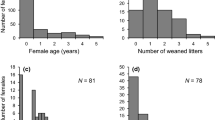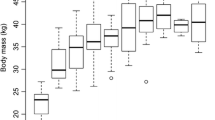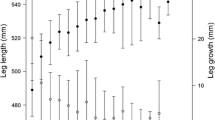Abstract
Central to the theory of life history evolution is the existence of trade-offs between different traits, such as the trade-off between early maturity and an extended period of body growth. Based on analysis of the reproductive tracts of harvested Eurasian lynx (Lynx lynx) females in Norway, we find that females that mature early are generally heavier than those that postpone maturation. A higher proportion of 1.5-year-old females showed signs of ovulation in areas with high prey density, where they were also heavier. Further, we show that female Eurasian lynx that mature early have the same number of placental scars (an index of breeding investment and litter size) as older females, suggesting that they have a relatively high investment in their first litter. This induces a cost in terms of body weight development, as those females that had matured at the age of 1.5 years were substantially lighter by the age of 2.5 years than those that postponed breeding. This effect tended to be more pronounced in areas with low prey density. We discuss to what extent this might affect their future fitness prospects, and suggest that such costs of maturing early in terms of body weight development might be high in terrestrial large carnivores due to a prolonged period of postnatal care.

Similar content being viewed by others
References
Andrèn H et al (2002) Estimating total lynx (Lynx lynx) population size from censuses of family groups. Wildl Biol 8:299–306
Bell G (1980) The costs of reproduction and their consequences. Am Nat 116:600–603
Breitenmoser-Würsten C et al (2007) Spatial and social stability of a Eurasian lynx (Lynx lynx) population: an assessment of 10 years of observation in the Jura Mountains. Wildl Biol 13:365–380
Burnham KP, Anderson DR (2002) Model selection and multimodel inference: a practical information-theoretic approach, 2nd edn. Springer, New York
Caro T (1987) Indirect cost of play: cheetah cubs reduce maternal hunting success. Anim Behav 35:295–297
Cole LC (1954) The population consequences of life history phenomena. Q Rev Biol 29:103–137
Danell AC, Andren H, Segerstrom P, Franzen R (2006) Space use by Eurasian lynx in relation to reindeer migration. Can J Zool 84:546–555
Descamps S, Boutin S, Berteaux D, Gaillard JM (2006) Best squirrels trade a long life for an early reproduction. Proc R Soc Lond B 273:2369–2374
Forslund P, Part T (1995) Age and reproduction in birds—hypothesis and tests. Trends Ecol Evol 10:374–378
Gaillard JM, Sempere AJ, Boutin JM, Vanlaere G, Boisaubert B (1992) Effects of age and body-weight on the proportion of females breeding in a population of roe deer (Capreolus capreolus). Can J Zool 70:1541–1545
Gaillard JM, Festa-Bianchet M, Delorme D, Jorgenson J (2000) Body mass and individual fitness in female ungulates: bigger is not always better. Proc R Soc Lond B 267:471–477
Gaillard JM, Loison A, Toigo C, Delorme D, Van Laere G (2003) Cohort effects and deer population dynamics. Ecoscience 10:412–420
Green WCH, Rothstein A (1991) Trade-offs between growth and reproduction in female bison. Oecologia 86:521–527
Henriksen HB et al (2005) Reproductive biology of captive female Eurasian lynx, Lynx lynx. Eur J Wildl Res 51:151–156
Herfindal I, Linnell JDC, Odden J, Nilsen EB, Andersen R (2005) Prey density, environmental productivity and home-range size in the Eurasian lynx (Lynx lynx). J Zool 265:63–71
Kvam T (1984) Age determination in European lynx (Lynx lynx) by incremental lines in tooth cementum. Acta Zool Fenn 171:221–223
Kvam T (1991) Reproduction in the European lynx, Lynx lynx. Z Saugetier 56:146–158
Lambin X, Yoccoz NG (2001) Adaptive precocial reproduction in voles: reproductive costs and multivoltine life-history strategies in seasonal environments. J Anim Ecol 70:191–200
Langvatn R, Mysterud A, Stenseth NC, Yoccoz NG (2004) Timing and synchrony of ovulation in red deer constrained by short northern summers. Am Nat 163:763–772
Laurenson MK (1995) Behavioural costs and constraints of lactation in free-living cheetahs. Anim Behav 50:815–826
Linnell JDC et al (2001) Home range size and choice of management strategy for lynx in Scandinavia. Environ Manage 27:869–879
Linnell JDC, Brøseth H, Odden J, Nilsen EB (2010) Sustainably harvesting a large carnivore? Development of Eurasian lynx populations in Norway during 160 years of shifting policy. Environ Manage 45:1142–1154
Nilsen EB, Linnell JDC, Odden J, Andersen R (2009) Climate, season, and social status modulate the functional response of an efficient stalking predator: the Eurasian lynx. J Anim Ecol 78:741–751
Odden J, Linnell JDC, Andersen R (2006) Diet of Eurasian lynx, Lynx lynx, in the boreal forest of southeastern Norway: the relative importance of livestock and hares at low roe deer density. Eur Wildl Res 52:237–244
Oli MK, Dobson FS (2003) The relative importance of life-history variables to population growth rate in mammals: Cole’s prediction revisited. Am Nat 161:422–440
Pedersen VA, Linnell JDC, Andersen R, Andren H, Linden M, Segerstrom P (1999) Winter lynx (Lynx lynx) predation on semi-domestic reindeer Rangifer tarandus in northern Sweden. Wildl Biol 5:203–211
Pettorelli N, Durant SM (2007) Longevity in cheetahs: the key to success? Oikos 116:1879–1886
R Development Core Team (2008) R: a language and environment for statistical computing. R Foundation for statistical computing, Vienna
Rutz C, Whittingham MJ, Newton I (2006) Age-dependent diet choice in an avian top predator. Proc R Soc Lond B 273:579–586
Schmidt K (1998) Maternal behaviour and juvenile dispersal in the Eurasian lynx. Acta Theriol 43:391–408
Skrondal A, Rabe-Hesketh S (2004) Generalized latent variable modeling: multilevel, longitudinal and structural equation models. Chapman & Hall/CRC, Washington
Stearns SC (1992) The evolution of life histories, 1st edn. Oxford University Press, Oxford
Sunde P, Overskaug K, Kvam T (1998) Culling of lynxes (Lynx lynx) related to livestock predation in a heterogenous landscape. Wildl Biol 4:169–175
Sunde P, Kvam T, Bolstad JP, Bronndal M (2000a) Foraging of lynxes in a managed boreal-alpine environment. Ecography 23:291–298
Sunde P, Kvam T, Moa P, Negard A, Overskaug K (2000b) Space use by Eurasian lynxes (Lynx lynx) in central Norway. Acta Theriol 45:507–524
Tavecchia G et al (2005) Predictors of reproductive cost in female Soay sheep. J Anim Ecol 74:201–213
Weladji RB et al (2008) Heterogeneity in individual quality overrides costs of reproduction in female reindeer. Oecologia 156:237–247
Williams GC (1966) Adaptation and natural selection. Princeton University Press, NJ
Yom-Tov Y, Yom-Tov S, MacDonald D, Yom-Tov E (2007) Population cycles and changes in body size of the lynx in Alaska. Oecologia 152:239–244
Yom-Tov Y, Kjellander P, Yom-Tov S, Mortensen P, Andrèn H (2010) Body size in the Eurasian lynx in Sweden: dependence on prey availability. Polar Biol 33:505–513
Zimmermann F, Breitenmoser-Wursten C, Breitenmoser U (2005) Natal dispersal of Eurasian lynx (Lynx lynx) in Switzerland. J Zool 267:381–395
Acknowledgments
This study is based on data from the Norwegian Large Predator Monitoring Program financed by the Ministry of the Environment through the Directorate for Nature Management in Norway. We are grateful to Frode Holmstrøm for conducting the post-mortems, Håkon Slutaas for making the prey distribution maps, and to the Directorate for Nature Management and the Norwegian Research Council for financing this study. This project was also partly supported by the European Commission under the 7th Framework Programme for Research and Technological Development. Three anonymous referees provided valuable comments on the manuscript.
Author information
Authors and Affiliations
Corresponding author
Additional information
Communicated by Janne Sundell.
Rights and permissions
About this article
Cite this article
Nilsen, E.B., Brøseth, H., Odden, J. et al. The cost of maturing early in a solitary carnivore. Oecologia 164, 943–948 (2010). https://doi.org/10.1007/s00442-010-1713-2
Received:
Accepted:
Published:
Issue Date:
DOI: https://doi.org/10.1007/s00442-010-1713-2




